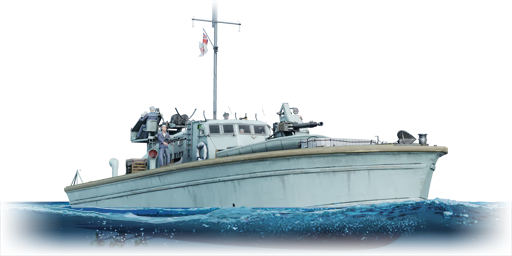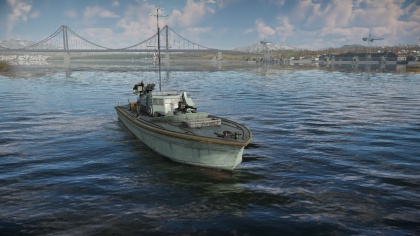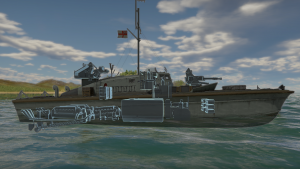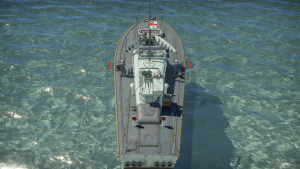MGB-75
Contents
Description
The 71 ft MGB-75 is a premium rank II British motor gun boat
with a battle rating of 2.0 (AB) and 2.3 (RB/SB). It was introduced in Update 1.91 "Night Vision".
General info
Survivability and armour
MGB-75 has the following armour layout:
- 2pdr QF Mk.IIc gunshield: 12.7 mm hardened armour
- Oerlikon Mk.V gunshield: 12.7 mm hardened armour
- Hull: 40 mm, wood
- Superstructure: 15 mm, wood
Any gun in the game will easily be able to penetrate anywhere on the boat, including the gunshields, at practically any range.
MGB-75 can be hull-broken by any gun with a diameter greater than 4 inches (102 mm). Hull-break triggers when a capable gun destroys any hull compartment or the bridge, resulting in instant destruction of the rest of the boat. At MGB-75's battle rating, the only guns capable of hull-breaking her are the 8cwt QF Mk I, found on Dark Adventurer, and the 10.5 cm SK C/32, found on AF D3. The ability to be hull-broken by guns larger than 4 inches is a trait that applies to the vast majority of boats in tier 1 and 2, so in that respect, MGB-75 isn't better or worse than most other boats.
MGB-75's hull is split into three compartments. The first compartment starts at the bow and ends just in front of the forward gun mount. The second starts at the forward gun mount and ends in front of the engines. The third starts at the engines and ends at the stern. Overall, with a crew complement of 12, survivability is average.
MGB-75 has four fairly large ammunition storages, two in front of the fore 2pdr QF Mk.IIc (40 mm) mount and two in front of the rear Oerlikon Mark V (20 mm) mount, housed in the superstructure. Destroying these will instantly destroy the rest of the boat. The two fore ammunition storages are only emptied when the only ammunition for the 2pdr QF Mk.IIc remaining is in the gun itself; the aft ammunition storages are only emptied when both the twin Oerlikon Mk.V mount and the two twin Lewis machinegun 1916 mounts run out of ammunition.
Mobility
| Mobility Characteristics | |||||
|---|---|---|---|---|---|
| Game Mode | Upgrade Status | Maximum Speed (km/h) | Turn Time (s) | Turn Radius (m) | |
| Forward | Reverse | ||||
| AB | Stock | 77 | 21 | ~29.18 | ~55.47 |
| Upgraded | 105 | 29 | ~19.63 | ~34.71 | |
| RB/SB | Stock | 67 | 19 | ~32.40 | ~62.46 |
| Upgraded | 78 | 22 | ~26.30 | ~50.00 | |
When moving forwards at high speeds, the bow will lift out of the water. This creates a blind spot in front of the boat where the 40 mm 2pdr QF Mk.IIc won't be able to depress far enough to engage surface targets.
MGB-75 has a displacement of 51.5 tons.
Armament
Primary armament
In her primary armament group, MGB-75 has one 40 mm 2pdr QF Mk.IIc automatic cannon in a single mount, mounted centerline in front of the bridge. It has 1,400 rounds of ammunition available. The mount can traverse horizontally at a rate of 25°/s and vertically at a rate of 25°/s. The gun has a magazine capacity of 56 rounds and has a rate of fire of 200 rounds/min. With a stock crew, it can be reloaded in 7.8 seconds; with an aced crew, it can be reloaded in 6 seconds. Its maximum range against surface targets is roughly 3.1 km.
| Guidance for the Primary Gun Turret | |
|---|---|
| Horizontal | Vertical |
| ±180° | -5°/+70° |
There are three choices of ammunition available:
- Universal: HEF/AP-T/HEF/AP-T
- 40 mm HE: HEF/HEF/HEF/AP-T
- 40 mm AP: AP-T/AP-T/AP-T/HEF
| Penetration Statistics | ||||||
|---|---|---|---|---|---|---|
| Ammunition | Penetration @ 0° Angle of Attack (mm) | |||||
| 10 m | 100 m | 500 m | 1,000 m | 1,500 m | 2,000 m | |
| Universal | 60 | 57 | 50 | 43 | 38 | 34 |
| 40 mm HE | 60 | 57 | 50 | 43 | 38 | 34 |
| 40 mm AP | 60 | 57 | 50 | 43 | 38 | 34 |
Secondary armament
In her secondary armament group, MGB-75 has two 20 mm Oerlikon Mk.II in a twin mount, mounted centerline behind the bridge. It has 4,080 rounds of ammunition available, 2,040 per gun. The mount can traverse horizontally at a rate of 75°/s and vertically at a rate of 75°/s. Each gun has a magazine capacity of 60 rounds and has a stated rate of fire of 450 rounds/min, though in actuality, the gun on the gunner's left side fires at a faster around, 485 rounds/min. With a stock crew, the guns can be reloaded in 8 seconds; with an aced crew, they can be reloaded in 4 seconds. Their maximum range against surface targets is roughly 2.1 km.
| Guidance for the Secondary Gun Turret | |
|---|---|
| Horizontal | Vertical |
| ±180° | -10°/+60° |
There are three choices of ammunition available:
- Universal: HEF-T/HEF-I/AP-T
- 20 mm HE: HEF-T/HEF-I/AP-T/HEF-I
- 20 mm AP: AP-T/AP-T/AP-T/HEF-I
| Penetration Statistics | ||||||
|---|---|---|---|---|---|---|
| Ammunition | Penetration @ 0° Angle of Attack (mm) | |||||
| 10 m | 100 m | 500 m | 1,000 m | 1,500 m | 2,000 m | |
| Universal | 39 | 36 | 29 | 23 | 20 | 17 |
| 20 mm HE | 39 | 36 | 29 | 23 | 20 | 17 |
| 20 mm AP | 39 | 36 | 29 | 23 | 20 | 17 |
Anti-aircraft armament
In her anti-aircraft armament group, MGB-75 has four 7.72 mm Lewis machinegun 1916s in two twin mounts, one on either side of the bridge. For each mount, there are 1,940 rounds of ammunition available, 970 rounds per gun, for a total of 3,880 rounds. There are no stated horizontal or vertical traverse rates given in-game, but the mounts handle very similarly, if not exactly, like other twin and quadruple 7.72 mm Lewis machinegun 1916 mounts which can traverse horizontally at a rate of 75°/s and vertically at a rate of 75°/s. Each gun has a magazine capacity of 97 rounds and has a rate of fire of 550 rounds/min. With a stock crew, the guns can be reloaded in 18.2 seconds; with an aced crew, they can be reloaded in 14 seconds. Their maximum range against surface targets is roughly 1.6 km.
| Turrets are named sequentially, clockwise, starting at the bow |
| Guidance for the Anti-Aircraft Gun Turrets | |||||||
|---|---|---|---|---|---|---|---|
| No.1 Turret (starboard) | No.2 Turret (port) | ||||||
| Horizontal | Vertical | Horizontal | Vertical | ||||
| -45°/+170° | -5°/+60° | -170°/+45° | -5°/+60° | ||||
There are no choices available. Though not directly stated in-game, there is one tracer round every other round, so the guns most likely fire the standard default ammunition choice of the 7.72 mm Lewis machinegun 1916, which has the following composition:
- Default: AP/T/AP/T
| Penetration Statistics | ||||||
|---|---|---|---|---|---|---|
| Ammunition | Penetration @ 0° Angle of Attack (mm) | |||||
| 10 m | 100 m | 500 m | 1,000 m | 1,500 m | 2,000 m | |
| Default | 20 | 19 | 16 | 13 | 11 | 10 |
Special armament
MGB-75 can carry two Mk.VII depth charges mounted amidships, one on each side in front of the twin 7.72 mm Lewis machinegun 1916 mounts facing outwards. The depth charges are dropped one at a time in this order (see the image):
- Starboard side
- Portside
Before spawning, the detonation time delay can be set anywhere between 3 seconds and 10 seconds.
| Depth Charge Characteristics | |||
|---|---|---|---|
| Mass (kg) | Explosive Type | Explosive Mass (kg) | TNT Equivalent (kg) |
| 196 | TNT | 130 | 130 |
Usage in battles
While the MGB-75's primary armament, the 40 mm 2pdr QF Mk.IIc, is a good weapon. It has a very good damage output, and, with a maximum range of roughly 3.1 km, it can outrange any opponent armed with 20 mm cannons. The gun can deal a lot of damage when the rounds hit; however, getting them to land may not always be the easiest task, mainly due to MGB-75's construction. MGB-75 has a relatively short hull, and she isn't particularly heavy for her size, so she is easily thrown around by rough waters. This, of course, makes accurately aiming the gun at long ranges practically impossible unless the sea is calm. In addition to this, MGB-75 has a planing hull, so the bow will lift out of the water when moving at high speeds. The 2pdr QF Mk.IIc can't depress far enough to compensate, so, when on the move, it won't actually be able to target most enemies in an area extending roughly 500 meters in front of the boat. Take care to either turn the hull or to slow down to engage enemies. Other shortcomings of the gun are its relatively long reload and that it's very easy to disable. For the former, if there are less than 20 or so rounds left in the magazine, it's best to fire off the remaining ammunition after each engagement to minimize the chance of needing to reload during the next engagement.
If the 2pdr QF Mk.IIc is knocked out or if it is reloading, switch to the secondary twin 20 mm Oerlikon Mk.V cannons. These guns have a shorter reload than the 40 mm, and they have a much faster traverse and elevation rates, so it tends to be better for close engagements. Since the default position of the mount is to face directly aft, it's best to have it targeting the enemy currently being engaged (default: X + 2) when not in use in order to have it already facing the enemy if it's needed. Of course, this also means that it won't be able to target any other boats or aircraft while the current target is still selected, so try not to be tunnel-visioned and always keep an eye on the surroundings. Aside from that, just like the 2pdr QF Mk.IIc, always be aware of how much ammunition is left in the magazines. If there are less than 40 rounds of so rounds left between the two guns, fire off the remaining ammunition to load a full magazine.
Be careful when engaging any enemy with 3-inch or larger guns. MGB-75 has large ammunition storages, and, if a 3-inch or larger HE round hits anywhere near the ammunition storages, especially the aft pair, it more often than not leads to an ammunition detonation. This is even more so with artillery fire. If the artillery warning displays, leave the area as soon as possible.
The fore 40 mm 2pdr QF Mk.IIc cannon can fire in ~143° to either side, centred forwards. As mentioned before, a blind spot is created when moving at high speeds which prevents the gun from firing in an area that extends ~500 ahead and which covers ~45° to either side. The aft twin 20 mm Oerlikon Mk.V cannons can fire in all directions except for a ~45° arc, centred forwards. When moving at high speeds, this blind arc is increased to ~75°.
- Ammunition Choices
For the 40 mm 2pdr QF Mk.IIc cannon, the best ammunition choice is the 40 mm HE because it has the highest ratio of HE rounds to AP rounds, meaning that it will be the most effective against both aircraft and surface targets. The 40 mm HE belt should be the main ammunition choice, but a few of the 40 mm AP belt should also be taken into battle for use against armoured targets.
For the 20 mm Oerlikon Mk.V cannons, the best ammunition choice is the 20 mm HE. There isn't much of a point in using the 20 mm AP belt because the primary armament is much more suited for engaging armoured targets anyway.
- Depth Charges
Being anti-submarine weapons and with the present lack of submarines in the game, there is practically no reason to use them. While they can be used against surface targets, this is extremely situational. Sailing up right next to a slower target and dropping a depth charge can lead to some success, though again, this is very situational. If attempting this, remember the order in which the depth charges drop and that there is no reason to use any depth charge activation time setting above the minimum 3 seconds, since higher delay times means the depth charge will sink further, and thus away, from the target. Again, it should be reiterated that this is very situational.
There is no practical reason to take them into battle, especially since, if they're not dropped, they essentially become unarmoured ammo racks.
Modules
| Tier | Seakeeping | Unsinkability | Firepower | |||
|---|---|---|---|---|---|---|
| I | Dry-Docking | Tool Set | 40 mm HE | 20 mm HE | Anti-Air Armament Targeting | |
| II | Rudder Replacement | Fire Protection System | Smokescreen | 40 mm AP | 20 mm AP | Auxiliary Armament Targeting |
| III | Propeller Replacement | Improved Rangefinder | Depth Charges | Primary Armament Targeting | ||
| IV | Engine Maintenance | New Pumps | Artillery Support | |||
Pros and cons
Pros:
- Powerful primary and secondary armament
- Both primary and secondary armament can rotate 360°
- Secondary armament: very good elevation and traverse rates; large magazine capacity; good firing arcs
Cons:
- Blind spot directly in front when moving at high speeds
- Primary armament: long reload; easily disabled
- Anti-aircraft armament: long reload; can only elevate 60°; low damage output
- Unstable firing platform in rough waters
- Large ammo racks
History
By early 1941, many of the British Power Boat Company (BPB) 60-foot, 63-foot, and 70-foot boats had been completed and were in Royal Navy Coastal Forces service, and already, their weaknesses began to show. The boats were small and lightly constructed, and the living condition for the crew was cramped. Additionally, because of their underpowered engines, they were slow. While their low top speed was certainly acceptable for the anti-submarine work, as they were initially built to perform, it was insufficient by 1941 as most of the boats had been converted into motor gun boats by this point. Thus, in 1941, BPB began designing a larger, faster boat.
BPB's new design had a length of 71 feet 9 inches (21.9 m), a beam of 20 feet 7 inches (6.3 m), and a draught of about 4 feet 3 inches (1.3 m). It was powered by three Packard petrol engines driving three shafts which allowed it to achieve a top speed of 42 knots. The BPB 71'9" boats formed the bulk of Coastal Forces' MGB fleet until the introduction of the larger and more heavily-armed Fairmile D boats. In total, 96 boats were built:
- MGBs 74-81: ordered in November 1940 as MA/SBs, all completed in 1942 as MGBs. Any surviving boats by September 1943 were refitted with a pair of 18-inch torpedo tubes and redesignated as MTBs 412-416. Any of the boats that survived the war were disposed of in October 1945.
- MGBs 107-119: ordered in November 1940 as MA/SBs, canceled in March 1941, and reordered in February 1942, all completed in 1942 as MGBs. Any surviving boats by September 1943 were refitted with a pair of 18-inch torpedo tubes and redesignated as MTBs 417-418 and 430-438. Any of the boats that survived the war were disposed of either in March 1945 or in October 1945. Their fates are as follows:
- MGBs 120-130: ordered in May 1942 as MGBs, all completed in 1943. All boats were refitted in September 1943 with a pair of 18-inch torpedo tubes and redesignated as MTBs 439-449. Most of the boats that survived the war were disposed of in October 1945.
- MTBs 450-489: ordered as MGBs, all completed between 1943-1945 as MTBs. Any of the boats that survived the war were disposed of at various dates or used as controlled targets.
- MTBs 490-500: ordered as MTBs, all completed between 1944-1945. Any of the boats that survived the war were disposed of at various dates or used as controlled targets, with the exception of MTB-496 and MTB-498. These were refurbished in 1949 and renumbered MTB-1596 and MTB-1598 to form the "Proud" class along with MTBs 1505-1509, MTB-1519, and MTB-1522. They were given the names "Proud Patriot" and "Proud Patroller", respectively. The "Proud" class boats were all sold in June 1958.
- MTBs 501-509: ordered as MTBs, all completed in 1945. All of the bats survived the war. MTBs 501-504 were sold or disposed of at various dates. MTBs 505-509 were refurbished in 1949 and renumbered MTBs 1505-1509 to form the "Proud" class along with MTB-1596, MTB-1598, MTB-1519, and MTB-1522. They were given the names "Proud Fusilier", "Proud Grenadier", "Proud Guardsman", "Proud Highlander", and "Proud Knight", respectively. The "Proud" class boats were all sold in June 1958.
- MTBs 519-522: ordered as MGBs, all completed in 1946 as MTBs. With the exception of MTB-520, they were refurbished in 1949 and renumbered MTB-1519, MTB-1521, and MTB-1522. MTB-1519 and MTB-1522 formed the "Proud" class along with MTBs 1505-1509, MTB-1596, and MTB-1598. They were given the names "Proud Lancer" and "Proud Legionary", respectively. The "Proud" class boats were all sold in June 1958.
MGB-75 was part of the original order placed in November 1940. She was ordered as a motor anti-submarine boat but was completed on 8th May 1942 as a motor gun boat. MGB-75 was commanded by the following:
- T/Lt. L.G.R. Campbell, RNVR: October 1942 to February 1943
- T/S.Lt. F.J. Head, RNVR: April 1943 to June 1943
- T/S.Lt. W.G.L. Salmon, RNVR: From June 1944 onwards
MGB-75 served as part of the 6th MGB Flotilla with HMS Beehive at Felixstowe through 1943. In September 1943, MGB-75 received her refit and was redesignated as MTB-413. Through 1944, MTB-413 served as part of the 1st MTB Flotilla at Portsmouth. MTB-413 survived the war and was disposed of in October 1945.
Media
See also
External links
- Coastal Forces Veterans - Boat Database
- unithistories.com - Royal Navy Coastal Forces 1940-1945
- naval-history.net - British vessels lost at sea in World War 2 - MGB, MTB, SGB, ML, etc - originally published in British Vessels Lost at Sea, 1935-45, His Majesty's Stationary Office, 1947
- NAVYPEDIA - MTB412 motor torpedo boats (93, 1942 - 1946)
- uboat.net - BPB 72 feet-type class
- yalumba.co.uk - British Power Boat Co Page 4
- Coastal Forces Heritage Trust - Boats
References
Bibliography
- Konstam, Angus (2010). British Motor Gun Boat 1939–45. Osprey Publishing Ltd. ISBN 978-1-84908-077-4.
| Britain boats | |
|---|---|
| Motor torpedo boats | Brave Borderer · Dark Aggressor · Dark Aggressor TD · Fairmile D (617) · Fairmile D (697) · Fairmile D (5001) · HMS Gay Archer |
| MTB-1(1) · MTB-1(2) · MTB Vosper · MTB Vosper(2) · MTB-422 | |
| Motor gun boats | Dark Adventurer · Fairmile A (ML100) · Fairmile B (ML345) · Fairmile C (312) · Fairmile C (332) · Fairmile D (601) · Fairmile H LCS(L)(2) |
| HMAS Arrow · HMAS Fremantle · MGB-61 · MGB-75 · ML 1383 · SGB Grey Fox · SGB Grey Goose | |
| Gunboats | HMS Spey |
| Britain premium ships | |
|---|---|
| Motor torpedo boats | MTB-1(2) · MTB-422 · Fairmile D (5001) · HMS Gay Archer |
| Motor gun boats | MGB-75 · SGB Grey Goose |
| Gunboats | HMS Spey |
| Sub-chasers | LÉ Orla |
| Frigates | HMS Whitby |
| Destroyers | HMS Montgomery · HMS Valhalla · HMS Verdun · ORP Garland · HMS Jervis · HMCS Haida · HMS Mohawk · HMS Cadiz · HMS Diamond |
| Light cruisers | HMS Belfast |
| Battleships | HMS Iron Duke |








